Greenhouse Gas Emissions and Yield of Durum Wheat Under Organic and Conventional Fertilization in Three Texture Classes
Abstract
1. Introduction
2. Materials and Methods
2.1. Experimental Site, Cropping System, Management, and Yield Measurements
2.2. Weather Conditions of Experimental Site
2.3. Soil N2O Flux Measurement and Cumulative Flux
2.4. Nitrogen Content, Soil Moisture
2.5. Calculations of N2O Intensity and Emission Factor
2.6. Statistical Analysis
3. Results
3.1. Yield and Its Components
3.2. Cumulative Soil N2O Emissions, Yield-Scaled N2O Emissions, and Emission Factor
3.3. Regression Analysis
4. Discussion
5. Conclusions
Author Contributions
Funding
Data Availability Statement
Acknowledgments
Conflicts of Interest
References
- Raza, A.; Razzaq, A.; Mehmood, S.S.; Zou, X.L.; Zhang, X.; Lv, Y.; Xu, J. Impact of Climate Change on Crops Adaptation and Strategies to Tackle Its Outcome: A Review. Plants 2019, 8, 34. [Google Scholar] [CrossRef] [PubMed]
- Prather, M.J.; Hsu, J.; DeLuca, N.M.; Jackman, C.H.; Oman, L.D.; Douglass, A.R.; Fleming, E.L.; Strahan, S.E.; Steenrod, S.D.; Søvde, O.A.; et al. Measuring and modeling the lifetime of nitrous oxide including its variability. J. Geophys. Res. Atmos. 2015, 120, 5693–5705. [Google Scholar] [CrossRef] [PubMed]
- Butterbach-Bahl, K.; Baggs, E.M.; Dannenmann, M.; Kiese, R.; Zechmeister-Boltenstern, S. Nitrous oxide emissions from soils: How well do we understand the processes and their controls Philosophical, Transactions of the Royal, Society. Biol. Sci. 2013, 368, 20130122. [Google Scholar] [CrossRef] [PubMed]
- Ciais, P.; Sabine, C.; Bala, G.; Bopp, L.; Brovkin, V.; Canadell, J.; Chhabra, A.; DeFries, R.; Galloway, J.; Heimann, M.; et al. Carbon and Other Biogeochemical Cycles. In Climate Change 2013: The Physical Science Basis. Contribution of Working Group I to the Fifth Assessment Report of the Intergovernmental Panel on Climate Change; Cambridge University Press: Cambridge, UK, 2013; pp. 465–570. [Google Scholar]
- Tian, H.; Lu, C.; Ciais, P.; Michalak, A.M.; Canadell, J.G.; Saikawa, E.; Huntzinger, D.N.; Gurney, K.R.; Sitch, S.; Zhang, B.; et al. The terrestrial biosphere as a net source of greenhouse gases to the atmosphere. Nature 2016, 531, 225. [Google Scholar] [CrossRef]
- Tiseo, I. Annual Nitrous Oxide Emissions Worldwide 1990–2021. Available online: https://www.statista.com/statistics/1379448/annual-global-nitrous-oxide-emissions/ (accessed on 20 October 2024).
- European Environment Agency. Annual European Union Greenhouse Gas Inventory 1990–2013 and Inventory Report 2015. Available online: https://www.eea.europa.eu/en/analysis/publications/european-union-greenhouse-gas-inventory-2015 (accessed on 20 October 2024).
- Han, J.-G.; Zhu, Y.-L.; Bai, H.-Y.; Qu, D.; Chu, J.Y.; Wu, C.D. N2O emission under different moisture and temperature regimes. Bull. Environ. Contam. Toxicol. 2007, 78, 284–287. [Google Scholar]
- Smith, P.; Martino, D.; Cai, Z.; Gwary, D.; Janzen, H.; Kumar, P. Agriculture. In Climate Change 2007: Mitigation Contribution of Working Group III to the 4th Assessment Report of the Intergovernmental Panel on Climate Change; Metz, B., Davidson, O.R., Bosch, P.R., Dave, R., Mayer, L.A., Eds.; Cambridge University: Cambridge, UK, 2007; pp. 497–540. [Google Scholar]
- Ravishankara, A.R.; Daniel, J.S.; Portmann, R.W. Nitrous oxide (N2O): The dominant ozone-depleting substance emitted in the 21st century. Science 2009, 326, 123–125. [Google Scholar] [CrossRef]
- Shakoor, A.; Xu, Y.; Wang, Q.; Chen, N.; He, F.; Zuo, H.; Yin, H.; Yan, X.; Ma, Y.; Yang, S. Effects of fertilizer application schemes and soil environmental factors on nitrous oxide emission fluxes in a rice-wheat cropping system, east China. PLoS ONE 2018, 13, e0202016. [Google Scholar] [CrossRef]
- Lv, F.; Song, J.; Giltrap, D.; Feng, Y.; Yang, X.; Zhang, S. Crop yield and N2O emission affected by long-term organic manure substitution fertilizer under winter wheat-summer maize cropping system. Sci. Total Environ. 2020, 732, 139321. [Google Scholar] [CrossRef]
- Bateman, E.J.; Baggs, E.M. Contributions of nitrification and denitrification to N2O emissions from soils at different water-filled pore space. Biol. Fertil. Soils 2005, 41, 379–388. [Google Scholar] [CrossRef]
- Li, Y.; Chen, J.; Drury, C.F.; Liebig, M.; Johnson, J.M.F.; Wang, Z.; Feng, H.; Abalos, D. The role of conservation agriculture practices in mitigating N2O emissions: A meta-analysis. Agron. Sustain. Dev. 2023, 43, 63. [Google Scholar] [CrossRef]
- Zhu, G.; Ma, X.; Gao, Z.; Ma, W.; Li, J.; Cai, Z. Characterizing CH4 and N2O emissions from an intensive dairy operation in summer and fall in China. Atmos. Environ. 2014, 83, 245–253. [Google Scholar] [CrossRef]
- Maillard, É.; Angers, D.A. Animal manure application and soil organic carbon stocks: A meta-analysis. Glob. Change Biol. 2014, 20, 666–679. [Google Scholar] [CrossRef] [PubMed]
- Rasool, R.; Kukal, S.S.; Hira, G.S. Soil physical fertility and crop performance as affected by long term application of FYM and inorganic fertilizers in rice–wheat system. Soil Tillage Res. 2007, 96, 64–72. [Google Scholar] [CrossRef]
- Yang, J.; Gao, W.; Ren, S. Long-term effects of combined application of chemical nitrogen with organic materials on crop yields, soil organic carbon and total nitrogen in fluvo-aquic soil. Soil Tillage Res. 2015, 151, 67–74. [Google Scholar] [CrossRef]
- Diacono, M.; Montemurro, F. Long-term effects of organic amendments on soil fertility. Sustain. Agric. 2011, 2, 761–786. [Google Scholar]
- Zhang, S.L.; Gao, P.C.; Tong, Y.A.; Norse, D.; Lu, Y.L.; Powlson, D. Overcoming nitrogen fertilizer over-use through technical and advisory approaches: A case study from Shaanxi Province, northwest China. Agric. Ecosyst. Environ. 2015, 209, 89–99. [Google Scholar] [CrossRef]
- Li, J.; Wen, Y.; Li, X.; Li, Y.; Yang, X.; Lin, Z.; Song, Z.; Cooper, J.M.; Zhao, B. Soil Labile Organic Carbon Fractions and Soil Organic Carbon Stocks as Affected by Long-Term Organic and Mineral Fertilization Regimes in the North China Plain. Soil Tillage Res. 2018, 175, 281–290. [Google Scholar] [CrossRef]
- Baggs, E.M.; Chebii, J.; Ndufa, J.K. A short-term investigation of trace gas emissions following tillage and no-tillage of agroforestry residues in western Kenya. Soil Tillage Res. 2006, 90, 69–76. [Google Scholar] [CrossRef]
- Chen, H.X.; Liu, J.J.; Zhang, A.F.; Chen, J.; Cheng, G.; Sun, B.H.; Pi, X.M.; Dyck, M.; Si, B.C.; Zhao, Y.; et al. Effects of straw and plastic film mulching on greenhouse gas emissions in Loess Plateau, China: A field study of 2 consecutive wheat-maize rotation cycles. Sci. Total Environ. 2017, 579, 814–824. [Google Scholar] [CrossRef]
- Xu, W.; Zhao, D.; Ma, Y.; Yang, G.; Ambus, P.L.; Liu, X.; Luo, J. Effects of long-term organic fertilizer substitutions on soil nitrous oxide emissions and nitrogen cycling gene abundance in a greenhouse vegetable field. Appl. Soil Ecol. 2023, 188, 104877. [Google Scholar] [CrossRef]
- Wei, X.R.; Hao, M.D.; Xue, X.H.; Shi, P.; Horton, R.; Wang, A.; Zang, Y.F. Nitrous oxide emission from highland winter wheat field after long-term fertilization. Biogeosciences 2010, 7, 3301–3310. [Google Scholar] [CrossRef]
- Huang, Y.; Zou, J.W.; Zheng, X.H.; Wang, Y.S.; Xu, X.K. Nitrous oxide emissions as influenced by amendment of plant residues with different C:N ratios. Soil Biol. Biochem. 2004, 36, 973–981. [Google Scholar] [CrossRef]
- Frimpong, K.A.; Baggs, E.M. Do combined applications of crop residues and inorganic fertilizer lower emission of N2O from soil? Soil Use Manag. 2010, 26, 412–424. [Google Scholar] [CrossRef]
- JinJin, Y.; Chen, H.; Tang, X.; Zhang, L.; Yan, J.; Li, S.; Chen, Y.; Li, X.; Wu, H.; Xiao, X. Combination of nitrogen and organic fertilizers reduce N2O emissions while increasing winter wheat grain yields and quality in China. Front. Environ. Sci. 2024, 12, 1485043. [Google Scholar]
- Cui, P.Y.; Fan, F.L.; Yin, C.; Song, A.L.; Huang, P.R.; Tang, Y.J.; Zhu, P.; Peng, C.; Li, T.Q.; Wakelin, S.A.; et al. Long-term organic and inorganic fertilization alters temperature sensitivity of potential N2O emissions and associated microbes. Soil Biol. Biochem. 2016, 93, 131–141. [Google Scholar] [CrossRef]
- Van Groenigen, J.W.; Velthof, G.L.; Oenema, O.; Van Groenigen, K.J.; Van Kessel, C. Towards an agronomic assessment of N2O emissions: A case study for arable crops. Eur. J. Soil Sci. 2010, 61, 903–913. [Google Scholar] [CrossRef]
- Mosier, A.R.; Halvorson, A.D.; Reule, C.A.; Liu, X.J. Net global warming potential and greenhouse gas intensity in irrigated cropping systems in northeastern Colorado. J. Environ. Qual. 2006, 35, 1584. [Google Scholar] [CrossRef]
- Venterea, R.T.; Bijesh, M.; Dolan, M.S. Fertilizer source and tillage effects on yield-scaled nitrous oxide emissions in a corn cropping system. J. Environ. Qual. 2011, 40, 1521–1531. [Google Scholar] [CrossRef]
- Van Kessel, C.; Venterea, R.T.; Six, J.; Adviento-Borbe, M.A.A.; Linquist, B.; Van Groenigen, K.J. Climate, duration, and N placement determine N2O emissions in reduced tillage systems: A meta-analysis. Glob. Change Biol. 2013, 19, 33–44. [Google Scholar] [CrossRef]
- Sainju, U.M. A global meta-analysis on the impact of management practices on net global warming potential and greenhouse gas intensity from cropland soils. PLoS ONE 2016, 11, e0148527. [Google Scholar] [CrossRef]
- Kim, D.G.; Giltrap, D. Determining optimum nitrogen input rate and optimum yield-scaled nitrous oxide emissions: Theory, field observations, usage, and limitations. Agric. Ecosys. Environ. 2017, 247, 371–378. [Google Scholar] [CrossRef]
- Chen, H.; Liao, Q.; Liao, Y. Response of area- and yield-scaled N2O emissions from croplands to deep fertilization: A meta-analysis of soil, climate, and management factors. J. Sci. Food Agric. 2021, 101, 4653–4661. [Google Scholar] [CrossRef] [PubMed]
- De Vita, P.; Taranto, F. Durum wheat (Triticum turgidum ssp. durum) breeding to meet the challenge of climate change. Adv. Plant Breed. Strateg. Cereals 2019, 5, 471–524. [Google Scholar]
- International Grains Council. 2023. Available online: https://www.igc.int/en/default.aspx (accessed on 20 October 2024).
- Nachit, M.M.; Elouafi, I. Durum adaptation in the Mediterranean dryland: Breeding, stress physiology, and molecular marker. Chall. Strateg. Dryland Agric. 2004, 32, 203–218. [Google Scholar]
- Aprile, A.; Havlickova, L.; Panna, R.; Mare, C.; Borrelli, G.M.; Marone, D.; Perrotta, C.; Rampino, P.; De Bellis, L.; Curn, V. Different stress responsive strategies to drought and heat in two durum wheat cultivars with contrasting water use efficiency. BMC Genom. 2013, 14, 821. [Google Scholar] [CrossRef]
- Iurlaro, A.; De Caroli, M.; Sabella, E.; De Pascali, M.; Rampino, P.; De Bellis, L.; Perrotta, C.; Dalessandro, G.; Piro, G.; Fry, S.C. Drought and Heat Defferentially Affect XTH Expression and XET Activity and Action in 3-Day-Old Seedlings of Durum Wheat Cultivars with Different Stress Susceptibility. Plant Sci. 2016, 7, 1686. [Google Scholar]
- Ranucci, S.; Bertolini, T.; Vitale, L.; Di Tommasi, P.; Ottaiano, L.; Oliva, M.; Magliulo, V. The influence of management and environmental variables on soil N2O emissions in a crop system in Southern Italy. Plant Soil 2001, 343, 83–96. [Google Scholar] [CrossRef]
- Rowell, D.L. Soil Science: Methods and Applications; Longman Ltd.: Harlow, UK, 1994; p. 61. [Google Scholar]
- Faber, A.; Jarosz, Z.; Jędrejek, A.; Rutkowska, A. Yield-scaled nitrous oxide emission from soils depending on nitrogen use efficiency characteristics. Pol. J. Environ. Stud. 2019, 28, 3155–3162. [Google Scholar] [CrossRef]
- Granli, T.; Bøckman, O.C. Nitrous oxide from agriculture. Norw. J. Agric. Sci. 1994, 12, 1–128. [Google Scholar]
- Sahrawat, K.L.; and Keeney, D.R. Nitrous oxide emission from soils. Adv. Soil Sci. 1986, 4, 103–148. [Google Scholar]
- Velthof, G.L.; Oenema, O. Nitrous oxide fluxes from grassland in the Netherlands: II. Effects of soil type, nitrogen fertilizer application and grazing. Eur. J. Soil Sci. 1995, 46, 541–549. [Google Scholar] [CrossRef]
- Tan, I.Y.S.; van Es, H.M.; Duxbury, J.M.; Melkonian, J.J.; Schindelbeck, R.R.; Geohring, L.D.; Hively, W.D.; Moebius, B.N. Single-event nitrous oxide losses under maizeproduction as affected by soil type, tillage, rotation, and fertilization. Soil Tillage Res. 2009, 102, 19–26. [Google Scholar] [CrossRef]
- Ottaiano, L.; Di Mola, I.; Di Tommasi, P.; Mori, M.; Magliulo, V.; Vitale, L. Effects of irrigation on N2O emissions in a maize crop grown on different soil types in two contrasting seasons. Agriculture 2020, 10, 623. [Google Scholar] [CrossRef]
- Vitale, L.; Polimeno, F.; Ottaiano, L.; Maglione, G.; Tedeschi, A.; Mori, M.; De Marco, A.; Di Tommasi, P.; Magliulo, V. Fertilizer type influences tomato yield and soil N2O emissions. Plant Soil Environ. 2017, 63, 105–110. [Google Scholar] [CrossRef]
- Chantigny, M.H.; Rochette, P.; Angers, D.A.; Bittman, S.; Buckley, K.; Massé, D.; Bélanger, G.; Eriksen-Hamel, N.; Gasser, M.O. Soil nitrous oxide emissions following band-incorporation of fertilizer nitrogen and swine manure. J. Environ. Qual. 2010, 39, 1545–1553. [Google Scholar] [CrossRef]
- Ball, B.C.; McTaggart, I.P.; Scott, A. Mitigation of greenhouse gas emissions from soil under silage production by use of organic manures or slow-release fertilizer. Soil Use Manag. 2004, 20, 287–295. [Google Scholar]
- He, T.; Yuan, J.; Luo, J.; Wang, W.; Fan, J.; Liu, D.; Ding, W. Organic fertilizers have divergent effects on soil N2O emissions. Biol. Fertil. Soils 2019, 55, 685–699. [Google Scholar] [CrossRef]
- Di Mola, I.; Ottaiano, L.; Sacco, A.; Senatore, M.; Mori, M. Organic versus mineral fertilization: Assessing of yield and quality of durum wheat in marginal lands. Ital. J. Agron. 2021, 16, 1855. [Google Scholar] [CrossRef]
- Tosti, G.; Farneselli, M.; Benincasa, P.; Guiducci, M. Nitrogen fertilization strategies for organic wheat production: Crop yield and nitrate leaching. Agron. J. 2016, 108, 770–781. [Google Scholar] [CrossRef]
- Rossini, F.; Provenzano, M.E.; Sestili, F.; Ruggeri, R. Synergistic effect of sulphur and nitrogen in the organic and mineral fertilization of durum wheat: Grain yield and quality traits in the Mediterranean environment. Agronomy 2018, 8, 189. [Google Scholar] [CrossRef]
- Davidson, E.A. Fluxes of nitrous oxide and nitric oxide from terrestrial ecosystems. In Microbial Production and Consumption of Greenhouse Gases: Methane, Nitrogen Oxides and Halomethanes; Rogers, J.E., Whitman, W.B., Eds.; American Society for Microbiology: Washington, DC, USA, 1991; pp. 219–235. [Google Scholar]
- Dobbie, K.E.; McTaggart, I.P.; Smith, K.A. Nitrous oxide emissions from intensive agricultural systems: Variations between crops and seasons, key driving variables, and mean emission factors. J. Geophys. Res. Atmos. 1999, 104, 26891–26899. [Google Scholar] [CrossRef]
- Ruser, R.; Flessa, H.; Russow, R.; Schmidt, G.; Buegger, F.; Munch, J.C. Emission of N2O, N2 and CO2 from soil fertilized with nitrate: Effect of compaction, soil moisture and rewetting. Soil Biol. Biochem. 2006, 38, 263–274. [Google Scholar] [CrossRef]
- Du, Y.; Guo, S.; Wang, R.; Song, X.; Ju, X. Soil pore structure mediates the effects of soil oxygen on the dynamics of greenhouse gases during wetting-drying phases. Sci. Total Environ. 2023, 895, 165192. [Google Scholar] [CrossRef]
- Song, X.T.; Wei, H.N.; Rees, R.M.; Ju, X.T. Soil oxygen depletion and corresponding nitrous oxide production at hot moments in an agricultural soil. Environ. Pollut. 2022, 292, 118345. [Google Scholar] [CrossRef]
- Di, H.J.; Cameron, K.C.; Podolyan, A.; Robinson, A. Effect of soil moisture status and a nitrification inhibitor, dicyandiamide, on ammonia oxidizer and denitrifier growth and nitrous oxide emissions in a grassland soil. Soil Biol. Biochem. 2014, 73, 59–68. [Google Scholar] [CrossRef]
- Zhu, X.; Burger, M.; Doane, T.A.; Horwath, W.R. Ammonia oxidation pathways and nitrifier denitrification are significant sources of N2O and NO under low oxygen availability. Proc. Natl. Acad. Sci. USA 2013, 110, 6328–6333. [Google Scholar] [CrossRef]
- Del Grosso, S.J.; Parton, W.J.; Mosier, A.R.; Ojima, D.S.; Kulmala, A.E.; Phongpan, S. General model for N2O and N2 gas emissions from soils due to dentrification. Glob. Biogeochem. Cycles 2000, 14, 1045–1060. [Google Scholar] [CrossRef]
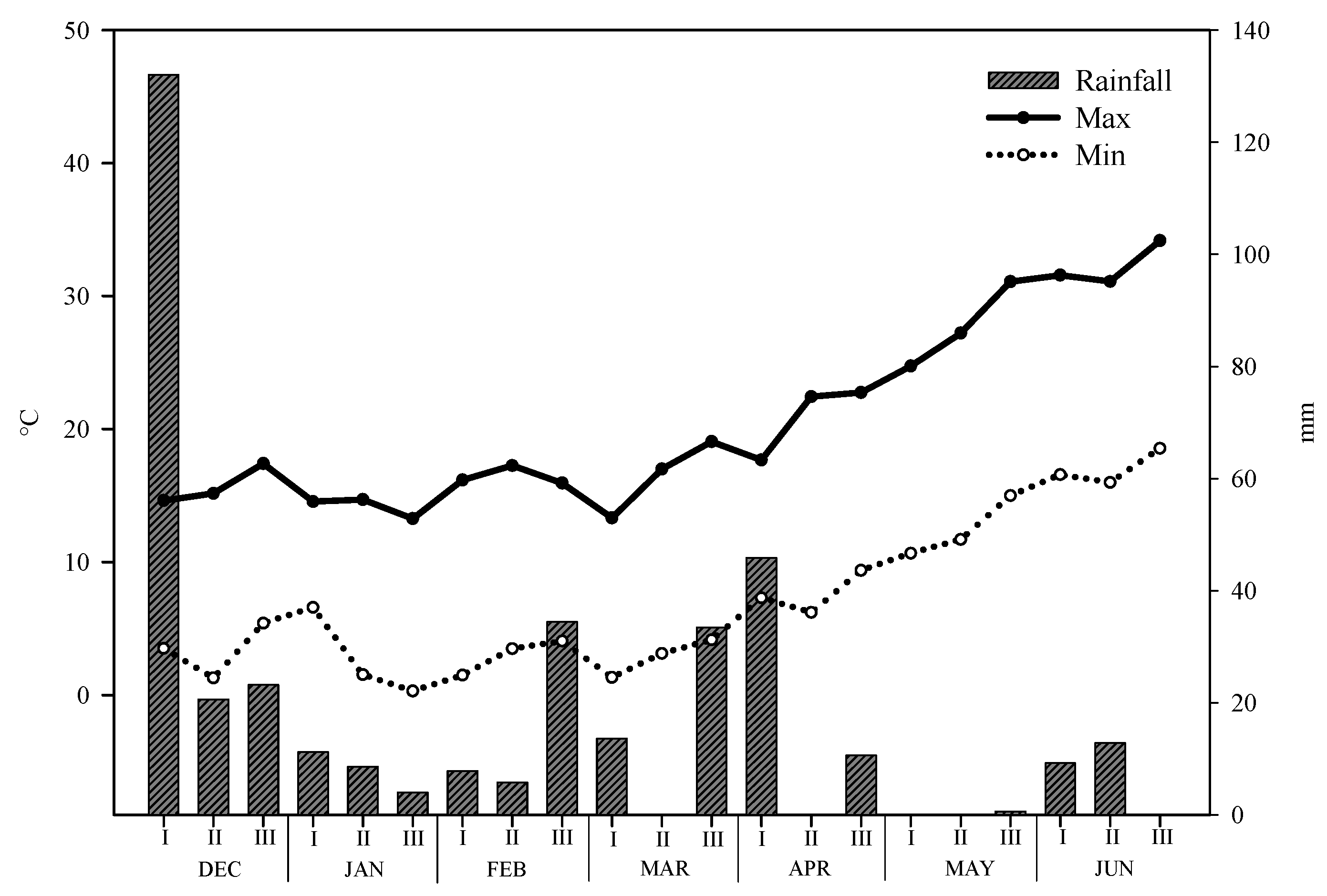
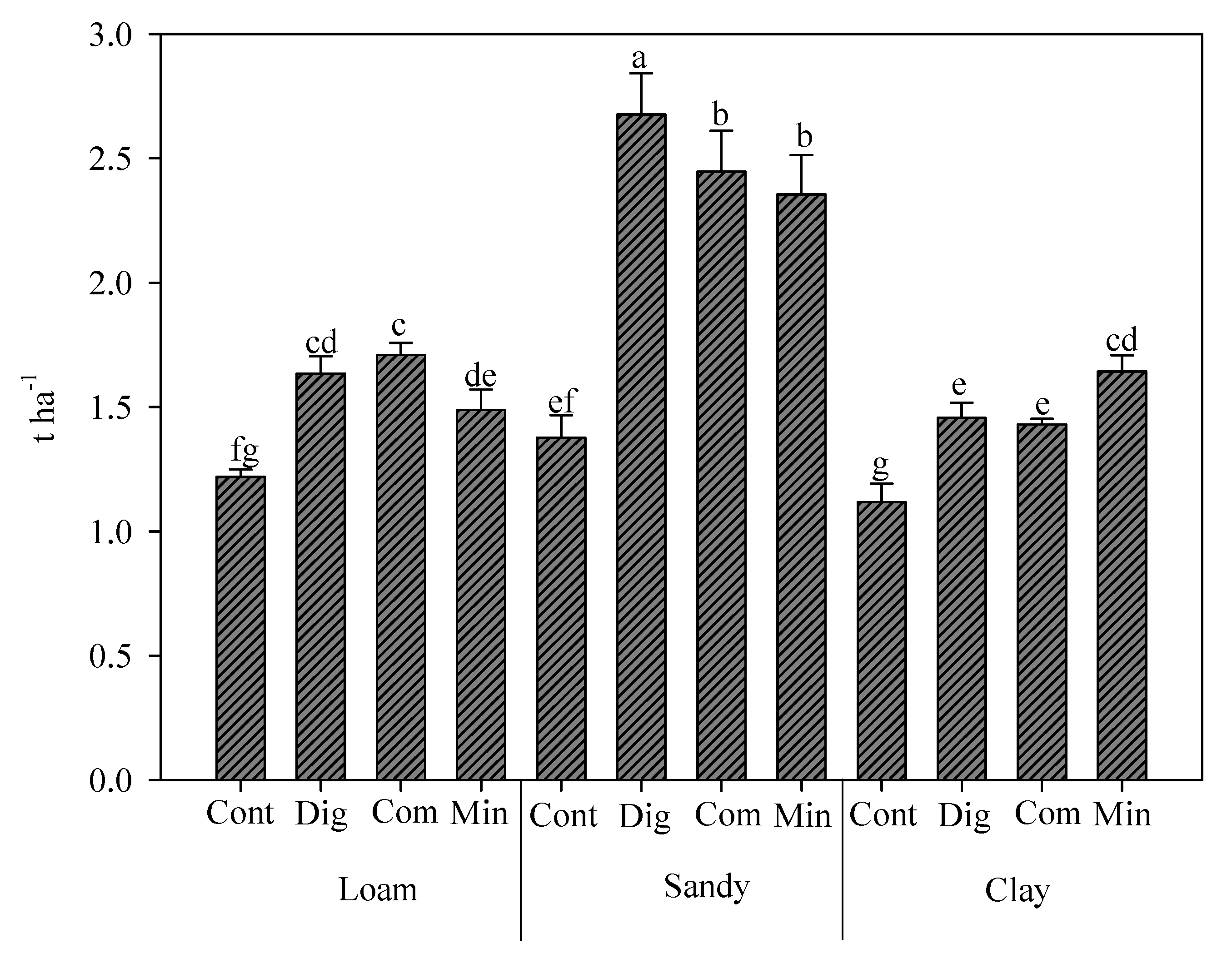

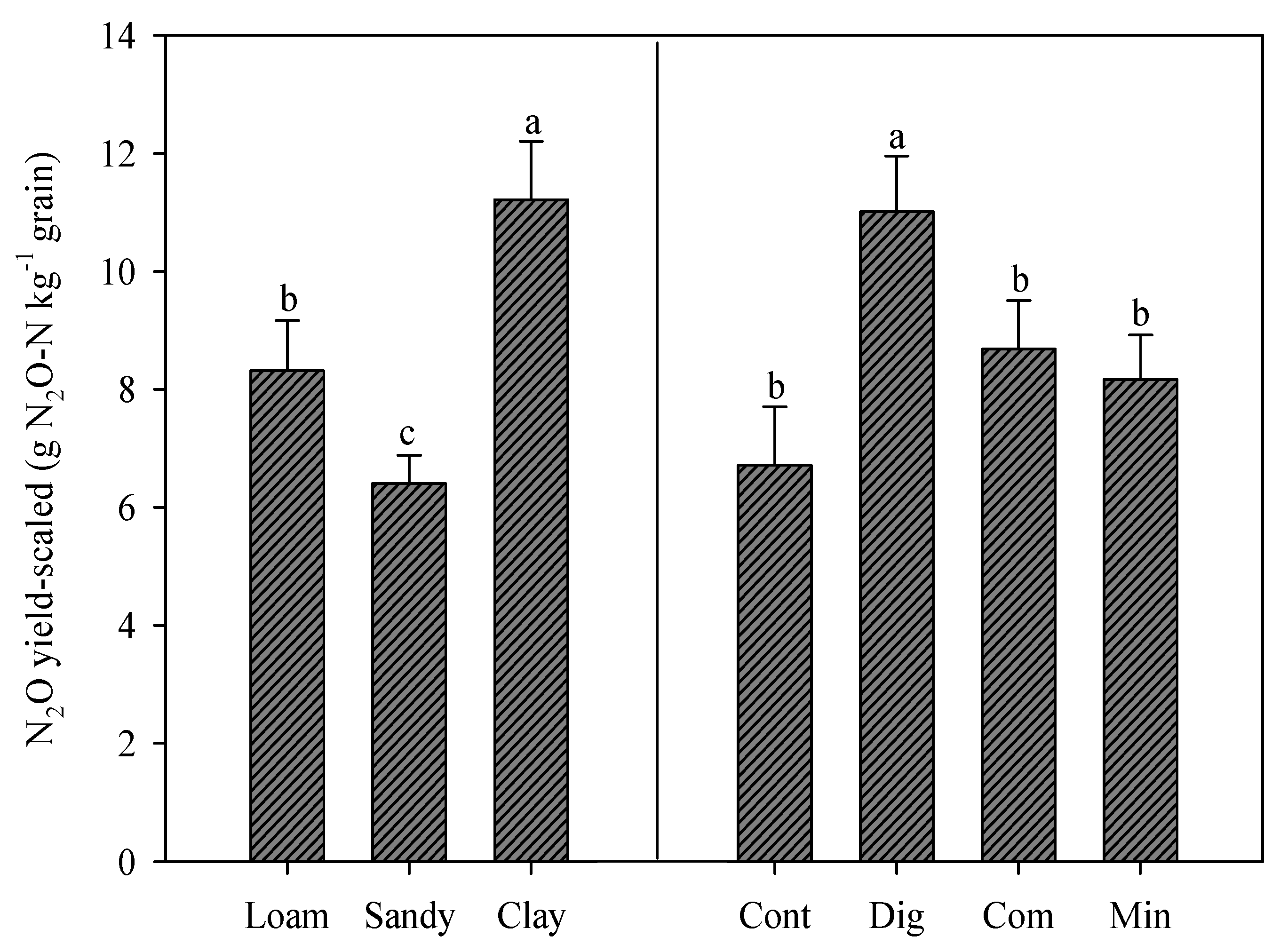
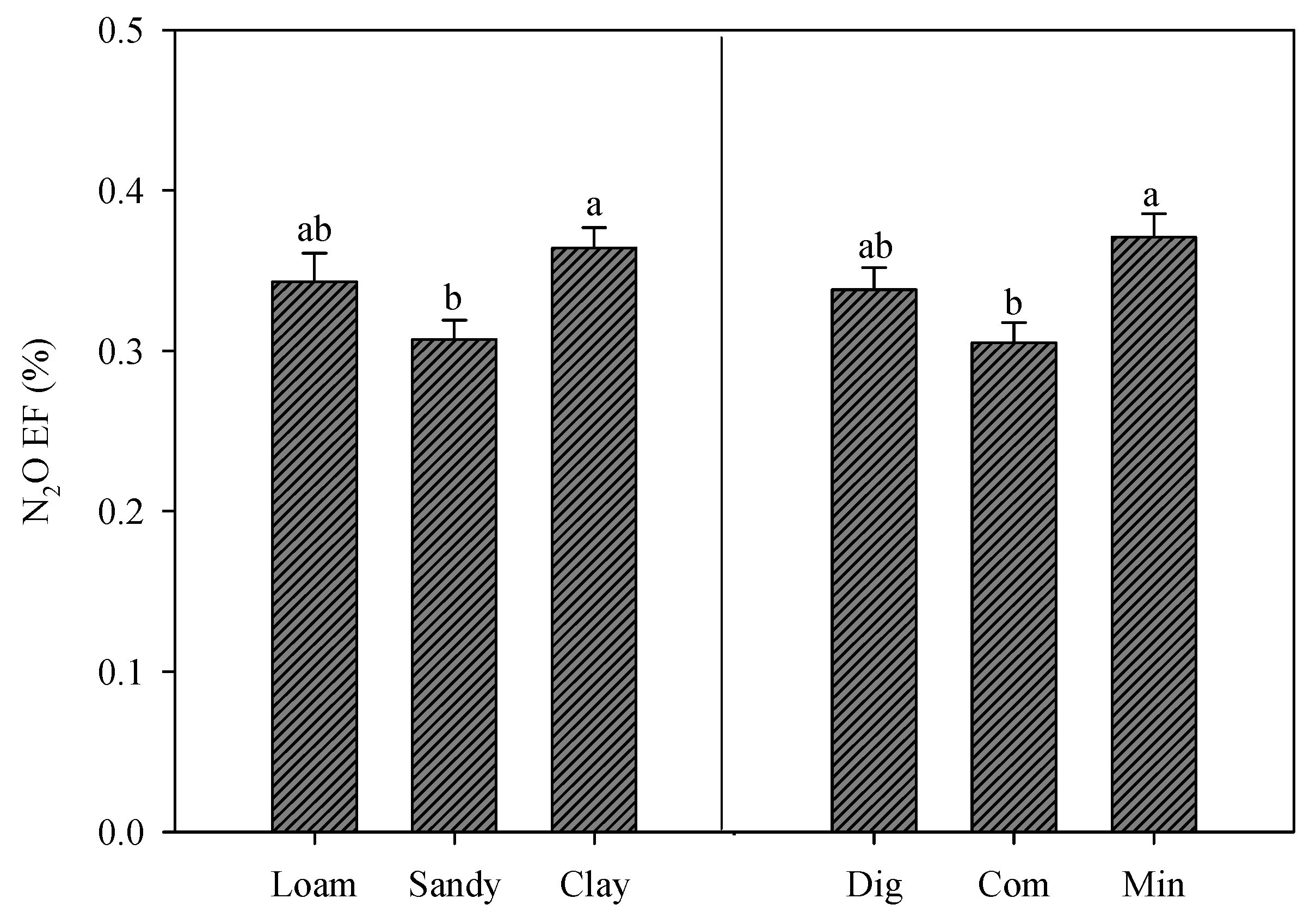

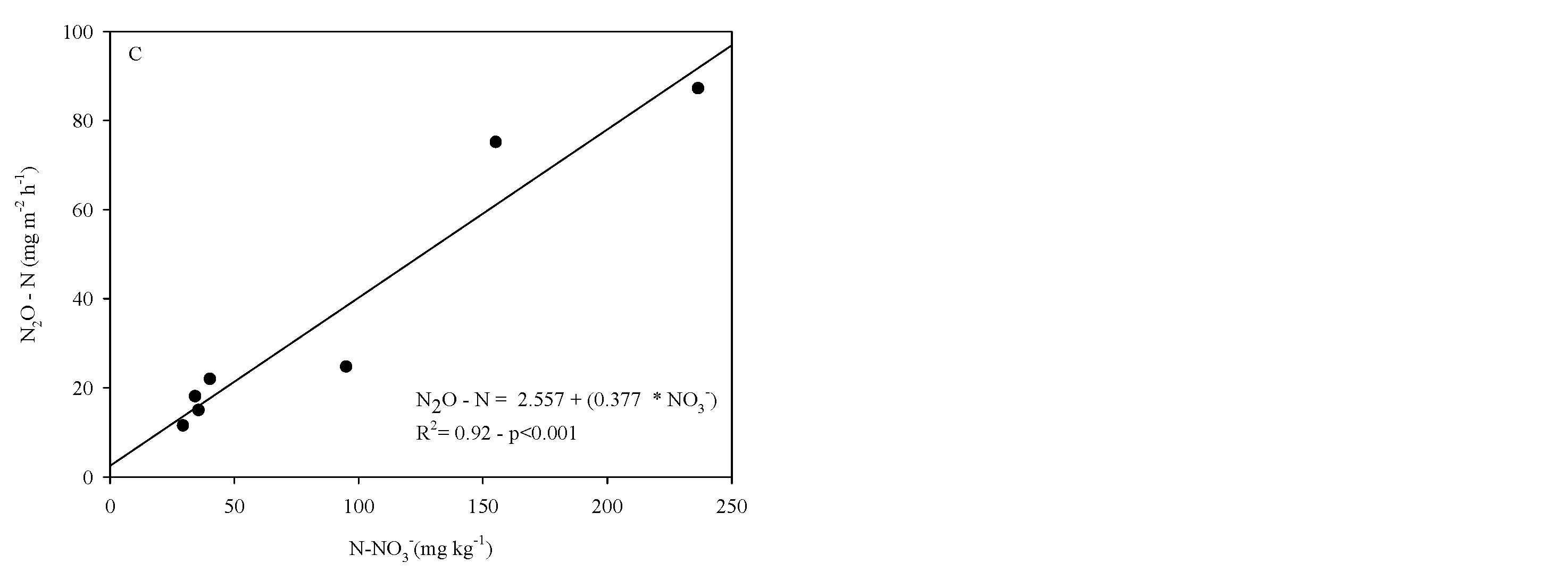
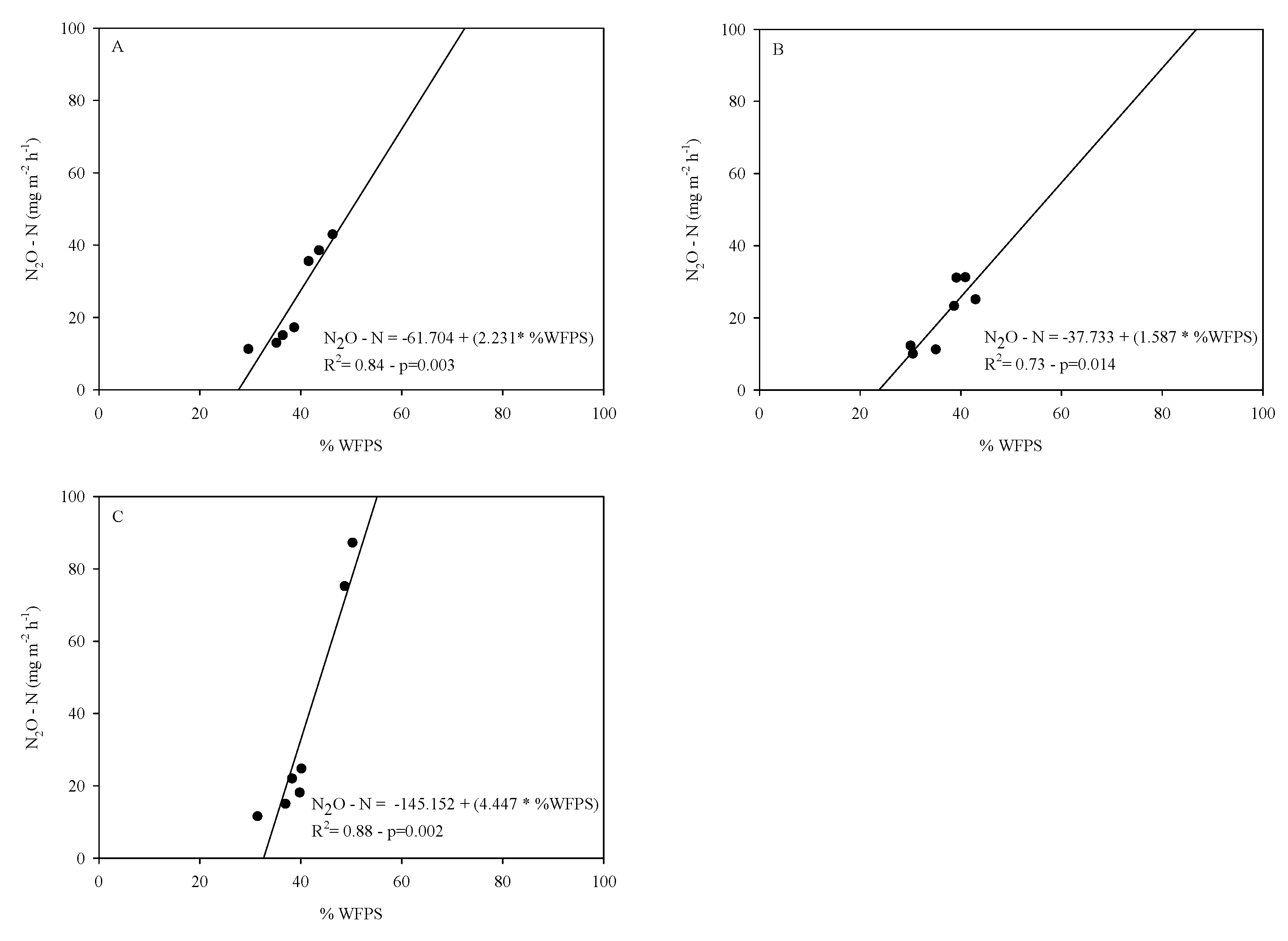
| Texture Classes (USDA) | Sand % | Silt % | Clay % | pH | OM % | N-Kjeldhal % | N-NO3 mg kg−1 | N-NH4 mg kg−1 | P mg kg−1 | K mg kg−1 |
|---|---|---|---|---|---|---|---|---|---|---|
| Clay | 36.0 | 24.5 | 39.5 | 7.7 | 1.6 | 0.08 | 17.4 | 8.2 | 112.8 | 602.0 |
| Sand | 70.5 | 23.0 | 6.5 | 7.8 | 1.0 | 0.07 | 62.3 | 13.4 | 106.1 | 1324.9 |
| Loam | 49.5 | 25.0 | 25.5 | 7.6 | 1.7 | 0.11 | 14.8 | 11.8 | 360.5 | 966.4 |
| Treatments | HI | Height | Vitreousness | Shrinking | Protein | |
|---|---|---|---|---|---|---|
| % | cm | % | % | % | ||
| Soil Type | Fertilization | |||||
| Loam | Cont | 30.7 ± 0.60 | 66.5 ± 3.00 | 10.0 ± 2.89 | 1.3 ± 0.67 bc | 14.7 ± 0.28 c |
| Dig | 33.7 ± 2.92 | 62.1 ± 1.10 | 16.7 ± 8.29 | 1.3 ± 0.67 bc | 12.5 ± 0.32 e | |
| Com | 33.7 ± 2.52 | 69.2 ± 2.20 | 8.3 ± 2.40 | 1.0 ± 0.58 bd | 15.0 ± 0.39 bc | |
| Min | 30.5 ± 1.04 | 65.7 ± 0.95 | 18.3 ± 4.41 | 0.7 ± 0.67 cd | 15.5 ± 0.63 b | |
| Sandy | Cont | 38.7 ± 2.13 | 65.7 ± 1.84 | 24.0 ± 2.08 | 0.0 ± 0.00 d | 9.1 ± 0.39 h |
| Dig | 38.7 ± 0.67 | 61.1 ± 2.48 | 36.7 ± 1.76 | 0.0 ± 0.00 d | 11.1 ± 0.50 f | |
| Com | 37.8 ± 0.73 | 70.2 ± 2.17 | 32.3 ± 1.20 | 0.0 ± 0.00 d | 10.7 ± 0.91 fg | |
| Min | 38.8 ± 0.17 | 67.0 ± 1.09 | 39.3 ± 2.85 | 0.0 ± 0.00 d | 13.8 ± 0.13 d | |
| Clay | Cont | 22.8 ± 0.33 | 65.7 ± 3.18 | 2.3 ± 1.20 | 4.0 ± 0.58 a | 11.2 ± 0.30 f |
| Dig | 29.7 ± 2.40 | 63.4 ± 3.41 | 19.3 ± 4.91 | 1.7 ± 0.88 b | 10.1 ± 0.65 g | |
| Com | 34.2 ± 1.01 | 62.1 ± 0.34 | 27.7 ± 9.13 | 0.3 ± 0.33 d | 12.5 ± 0.53 e | |
| Min | 36.7 ± 4.17 | 65.4 ± 4.23 | 25.7 ± 2.85 | 0.3 ± 0.33 d | 16.8 ± 0.26 a | |
| Significance | ||||||
| Soil Type (ST) | ** | NS | ** | ** | ** | |
| Fertilization (F) | ** | NS | ** | ** | ** | |
| ST × F | NS | NS | NS | * | ** | |
Disclaimer/Publisher’s Note: The statements, opinions and data contained in all publications are solely those of the individual author(s) and contributor(s) and not of MDPI and/or the editor(s). MDPI and/or the editor(s) disclaim responsibility for any injury to people or property resulting from any ideas, methods, instructions or products referred to in the content. |
© 2025 by the authors. Licensee MDPI, Basel, Switzerland. This article is an open access article distributed under the terms and conditions of the Creative Commons Attribution (CC BY) license (https://creativecommons.org/licenses/by/4.0/).
Share and Cite
Ottaiano, L.; Di Mola, I.; Vitale, L.; Cozzolino, E.; Pelosi, M.E.; Maglione, G.; Mori, M. Greenhouse Gas Emissions and Yield of Durum Wheat Under Organic and Conventional Fertilization in Three Texture Classes. Agronomy 2025, 15, 702. https://doi.org/10.3390/agronomy15030702
Ottaiano L, Di Mola I, Vitale L, Cozzolino E, Pelosi ME, Maglione G, Mori M. Greenhouse Gas Emissions and Yield of Durum Wheat Under Organic and Conventional Fertilization in Three Texture Classes. Agronomy. 2025; 15(3):702. https://doi.org/10.3390/agronomy15030702
Chicago/Turabian StyleOttaiano, Lucia, Ida Di Mola, Luca Vitale, Eugenio Cozzolino, Maria Eleonora Pelosi, Giuseppe Maglione, and Mauro Mori. 2025. "Greenhouse Gas Emissions and Yield of Durum Wheat Under Organic and Conventional Fertilization in Three Texture Classes" Agronomy 15, no. 3: 702. https://doi.org/10.3390/agronomy15030702
APA StyleOttaiano, L., Di Mola, I., Vitale, L., Cozzolino, E., Pelosi, M. E., Maglione, G., & Mori, M. (2025). Greenhouse Gas Emissions and Yield of Durum Wheat Under Organic and Conventional Fertilization in Three Texture Classes. Agronomy, 15(3), 702. https://doi.org/10.3390/agronomy15030702








